
If you have never owned a deaf dog, you may find the concept daunting.
But the truth is that with a few tweaks in how things are done, caring for a deaf dog is just as much work as caring for a hearing one.
Here are all the things you should know before you jump in.
Taking Care of a Deaf Dog: What To Expect
Being a dog parent isn't always a walk in the park, and when you add that a dog is differently “abled,” i.e., deaf, it throws an extra twist into the mix.
While you learn to adjust over time and life becomes routine, the first few months of adjustment can be tricky.
Here are a few things you should know and consider before you commit to adopting a deaf dog.
Training is mandatory
Training is mandatory for any dog, but it's even more important for deaf animals because, unlike hearing dogs, your deaf dog can only interpret what you are saying from your expressions, your body language, and your hand signals.
While a healthy-hearing dog has the added benefit of hearing the tone of your voice, a dog with no hearing doesn't have that luxury.
Think about how often you get your dog's attention with a word, then remember that this doesn't work when your dog is deaf.
Your dog will likely be deaf forever
Some people tend not to think about the long-term when bringing home a special needs animal.
You may rescue a deaf dog because you feel like you are doing something good, but you need to know that when the “novelty” of doing something good wears off, your dog will still be deaf.
They will still face unique challenges, and you will still have to serve as your dog's “go-to guy/gal.”
Training your deaf dog will be more challenging.
If you think you grasp dog training, know that when you adopt a deaf pet, everything you ever thought you knew will only be partially applicable.
For example, you may know how to get a dog to sit.
But if your dog can't hear the command, you will have to find a way to communicate what you want with one hand while performing the mechanics behind the “sit” on the other.
It'll take some getting used to, but as I mentioned before, once you find a rhythm, owning a deaf pup is not that much different from owning a hearing dog.
Caring For A Deaf Dog: 10 Tips
Learn Hand Signals Ahead of Time
If you know that you are going to be adopting a dog who's deaf, spend some time researching the various methods of communication that are available to you.
For example, can your pooch hear enough to hear a certain pitched sound that you could use in training?
Perhaps they don't hear at all and you decide to learn American sign language to communicate with your dog – it can be very effective.
Here are some helpful videos on learning hand signals for dogs:
- Recommended ASL Signs for Deaf Pets
- The Basics of Training by K9 Connection
- Example Video of Training a Deaf Pup
Know the Unique Needs of Your Dog
If you are considering adopting a deaf pet, it's important that you fully understand any unique needs that they may have.
For example, do they have additional medical conditions that caused their deafness and that have a lifelong impact on your dog's health?
Does your deaf dog require specialty medication and if so, can you afford that medication for the full life of your pooch?
It's essential to know as much as possible about your dog's condition so that you can provide the best care possible for them and be sure that you can provide that care financially throughout their lifetime.
If your deaf pupper will require specialty medications and you can afford them, do you know how to administer them, or do you need a vet to show you how?
If you need help, be sure that you follow up on that “how to” before bringing your new canine home so that they don't have to go without necessary medications.
Meeting Your Deaf Pupper
One of the biggest obstacles people run into when it comes to deaf dogs is meeting that animal for the first time.
If you're experienced with dogs at all, then you know that a lot of their reaction to meeting you is based on your body language; this doesn't change when your dog is deaf.
Deaf dogs will rely on your body language when they first meet you more than your average dog, so you must give them the right signs and signals.
Some good tips to remember when meeting your future deaf pet for the first time include:
- Avoid direct eye contact during the first part of the meeting as this can feel threatening; try to look slightly off to one side instead.
- If you're smiling, don't show teeth, this can be interpreted as a sign of aggression.
- Avoid bending over the dog as this can make them feel threatened. Instead, try to walk up beside them and offer an open palm to them slowly. This gives your deaf dog the chance to “investigate” you.
- Avoid doing anything that may startle or stun the dog; for example, sudden movements or walking straight towards the dog with a heavy stride.
Once your deaf puppy or adult canine has been introduced to you, if they seem comfortable with you, spend a little time getting to know them and providing plenty of positive reinforcement.
Bringing a Deaf Pet Home
Before you bring home your deaf dog, you may find it beneficial to go through your home and ensure that it is a safe environment.
This is something that owners of blind dogs do frequently, but new owners of deaf dogs don't think much of it.
Here are a few pointers to start you on the right track:
- Use a baby gate or a special pet gate to block off other stories of the home. This way you can better manage your dog's environment and they will be able to keep you in eyeline without getting disoriented in a new home.
- Keep a regular routine. All dogs thrive on routine but for a dog who can't hear, this routine is even more important in letting them know what to expect from their new life and avoiding causing additional stress.
- Learn about training and sign language for dogs. Then, use hand signals with commands from the very first moment you bring your deaf dog home.
- Be mindful of your facial expression and body posture at all times.
- Do everything possible to avoid surprising or startling your deaf pet. We recommend walking a little more heavily on the floor or wearing hard-soled slippers that will create vibrations on the floor to announce your movements, at least at the beginning.
Finding a Vet
Most veterinarians will have experience with deaf animals, but depending on the cause of your dog's deafness, you may want to seek out a vet who specializes in that condition.
I personally recommend asking fellow owners of deaf pets for recommendations or even hopping online to do a little research.
It's not mandatory to find a vet who has experience with deaf dogs, but it can help your pooch to feel more comfortable if your veterinarian understands how to work around a deaf canine.
6. Join a Deaf Dog Forum or Support Group
If you are new to deaf dog ownership, it can be particularly helpful to join an online forum for owners of deaf pets, and also seek support from dog owners on Reddit, for example.
Here are some forums, pages, and groups you can visit:
- Connect with Owners of Deaf Pets
- Deaf Dogs Rock Facebook Page
- Deaf Dog Network Facebook Page
- Education Action Fund Site
- Pets With Disabilities Facebook Page
This gives you a resource for asking questions that you may have about handling your deaf Fido, gives you access to tips and tricks to make your deaf pup's life easier, and provides you with points of contact who can help you provide your dog with services like grooming that are experienced with non-hearing animals.
Don't Lose Touch with Your Rescue Group
If you rescued your deaf puppy or adult pet from a rescue group specializing in deaf dogs, it's even more important for you to stay in touch with them than it may otherwise be.
The reason for this is that they can serve as a local support network for you, provide local services who have services tailored specifically to deaf animals, and even put you in touch with other local deaf pet owners so both you and your dog can meet and greet with like-minded people and dogs.
Training a Deaf Dog
We've already touched on the fact that training a hearing-impaired dog can be challenging for an inexperienced owner, but it is a crucial aspect of raising a healthy and happy dog.
If you aren't confident in your ability to train a deaf dog, contact your local rescue group or online community forum and ask for referrals to local trainers who can help you.
Don't write off training your deaf pup as a struggle that is “too hard.”
Instead, find the resources you need to make it happen – it's very doable.
The AKC and Best Friends have some fabulous articles on training deaf dogs, which I highly recommend reading at least once over if you are considering adopting or fostering a hearing-impaired animal.
Products for Deaf Dogs
What matters in a happy and healthy relationship with your hearing-impaired pooch is your understanding of how to care for them.
The above resources will be very helpful in accomplishing that goal.
That said, to make matters even easier for you and your doggo, you can also seek out some dog products that are specifically tailored or are particularly useful for deaf dogs and/or owners of deaf pets. Here are some suggestions.
“I'm Deaf” Dog Tag
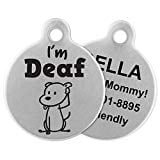 Dog tags are important for all pets, but they're particularly crucial to have for dogs who cannot hear.
Dog tags are important for all pets, but they're particularly crucial to have for dogs who cannot hear.
If your pooch ever gets lost, anybody who finds him needs to know immediately that the dog cannot hear them.
These “I'm Deaf” pet tags are the highest-rated option I could find.
They're good quality, have an appealing look, and have enough space to provide all essential info about your pup. It's the #1 most suggested item by owners of deaf animals.
No-pull Harness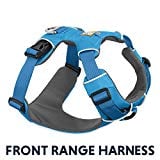
Even if you train your pooch well, the fact that he or she cannot hear remains a disadvantage for both of you.
When walking your dog, it's best to avoid a collar-leash combo and stick with a high-quality no-pull harness, which has been scientifically proven to be safer for all dogs (not just deaf ones).
There are several great quality no-pull harnesses out there, so take your pick.
This Ruffwear Front Range is our editors' favorite, which you can pair with a “Deaf Dog” sticker I mention below.
“Deaf Dog” Patch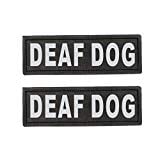
These are hook and loop patches that you can use for your dog harness.
Even if you already have a dog ID tag and/or collar that says your pup is hearing impaired, those things aren't always clearly visible or quickly noticed.
When walking your pup, it's a good idea to let everyone around know that the dog will not react to sounds.
Out of all the available stickers/patches, these ones, in particular, seem to be the best quality, most reliable, and well-reviewed by other owners of deaf dogs.
Vibration Only Collar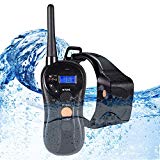
As I've said above, training a deaf pet will be one of the biggest challenges for you.
Using a vibration-only dog training collar (not a shock collar!) can be of immense help, according to many other owners of deaf pets.
This one, in particular, made by Wolfwill, seems to be the favorite among other owners of hearing impaired dogs and it's fairly highly rated on Amazon.
It's completely waterproof with a multi-function remote that allows for many options with a simple design of only 3 main buttons.
Pet Gate
 As I've mentioned in the first part of this guide, once you bring a deaf animal into your home, you're likely to use a baby gate or pet gate for training them.
As I've mentioned in the first part of this guide, once you bring a deaf animal into your home, you're likely to use a baby gate or pet gate for training them.
You don't have to, but it will be extremely useful and make things easier for you and your pup.
Once again, there are many brands and options available, so do your research and pick the one that fits your needs best.
The Regalo pet gate is one of the best in terms of its cost-for-value; it's affordable, good quality and highly praised by other owners and our editors here at Top Dog Tips.
Pet Stroller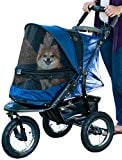
Finally, this is not an essential item for hearing dogs or hearing-impaired ones.
However, a dog stroller can be very useful for owners of dogs with hearing problems, especially when you're still going through the initial stages of training and particularly so with a deaf puppy.
Samantha has previously reviewed many dog strollers and tested different brands, so I recommend reading her article and watching the video.
The Pet Gear No Zip pet stroller is one of our favorites and fits many types of dogs.
The above dog supplies for deaf dogs aren't essential but they can come to be extremely useful, especially for people who are new to caring for hearing impaired animals and are just about to go through the initial training phase.
10. Books on Caring for Deaf Pups
My final suggestion for anybody thinking of adopting a deaf pooch, or having just adopted one, is to not only research and read online but grab a book (or maybe three) for more detailed explanations and stories from other owners of hearing-impaired animals.
Below are some of my favorite books on the subject.
- Signs for Deaf Dogs (BSL) by Cath Smith
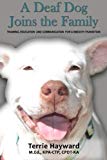
- Through A Dark Silence by Debbie Bauer
- Living With a Deaf Dog by Susan Cope Becker
The above four books are a mixture of training and care advice and stories from people who have adopted one or more deaf pets that can be extremely inspirational and educational for anybody about to do that.
Deaf Dogs Ownership FAQs
“Can I own a deaf dog in a household with children?”
Yes! As a parent, you should always teach your children how to interact properly and safely with animals.
Yes, this teaching will be a little different for children who will be around deaf pups, but it's no more work than it is with a “typical” dog.
However, it's important to know your deaf pet before bringing them home.
If they just don't like children, they're not going to start liking children just because you gave them a home.
Get to know any dog's personality before you bring them home to a household with children.
“How do I get my deaf dog to look at me?”
Because your dog is deaf you will have to use a technique other than calling them to get their attention.
One of the most effective methods of calling your deaf dog's attention is to thump the heel of your foot on the floor to cause vibrations.
Other owners of deaf dogs rely on vibration collars (these are NOT the same as shock collars).
These collars vibrate gently around your dog's neck to let them know they are being called.
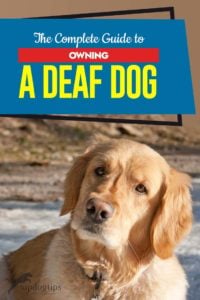 It's also important to teach your deaf animal a command for “Look”.
It's also important to teach your deaf animal a command for “Look”.
We taught our first black Labrador this command even though he was hearing it because it was one word that automatically let him know that we wanted him to look at us and stop what he was doing.
As your deaf puppy gets used to living with you and learning to obey your hand signals, they will learn to look to you naturally when they see you signing or carrying out a command that they are familiar with.
Until then, we recommend teaching the “look” command using hand signals accompanied with deliciously stinky treats that will capture your dog's attention.
“I have more questions about caring for deaf dogs.”
If you have any other questions about owning a deaf animal, it's best to consult your veterinarian, the rescue you adopted from, or if you joined an online community, which is a great resource too.
If you're feeling overwhelmed and don't know where to start, we recommend heading over to the blog Deaf Dogs Rock where Julia Levitt and her deaf pooch Nitro share their life experiences together.
READ NEXT: The Complete Guide to Fostering a Dog













